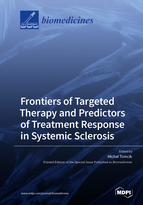Frontiers of Targeted Therapy and Predictors of Treatment Response in Systemic Sclerosis
A special issue of Biomedicines (ISSN 2227-9059). This special issue belongs to the section "Molecular and Translational Medicine".
Deadline for manuscript submissions: closed (30 June 2022) | Viewed by 36265
Special Issue Editor
Interests: systemic sclerosis; inflammatory myopathies; rheumatoid arthritis; spondyloarthritis; biomarkers; potential anti-fibrotic therapy; animal models of dermal fibrosis; atherosclerosis; cardiovascular risk; body composition; rehabilitation; sexual dysfunction
Special Issue Information
Dear Colleagues,
Systemic sclerosis (scleroderma, SSc) is the most enigmatic and challenging of all rheumatic diseases. To date, it is considered incurable and carries the highest cause-specific mortality of all connective tissue diseases. Despite advancements in basic, translational, and clinical research in recent years, the etiology and pathophysiology of this complex and heterogeneous condition remain to be elucidated. The heterogeneity, highly variable clinical presentations, multisystemic manifestations, natural history, response to treatment, and low prevalence, level of public awareness, or government investment represent some of the reasons for the slow progress so far. Despite the large numbers of clinical trials and the progress made in their design over the last decade, no approved disease-modifying therapies exist for SSc to date. Currently available pharmacological therapies predominantly target inflammatory and vascular pathways, have variable and unpredictable clinical efficacy, usually undesirable safety profiles, and only a modest effect on long-term survival. Therefore, there is a substantial unmet need for novel potential therapeutic targets targeting the main pathological features of this disease (alterations in the immune and vascular systems leading to progressive tissue fibrosis). There is also a large unmet need for potential predictors of treatment response of the currently available therapies to optimize the stratification of patients with this heterogeneous disease in order to minimize possible adverse events and maximize the potential benefit of therapy. Hopefully, novel advancements in these aspects of the management of SSc will contribute to a reduction of suffering and disability and improvement in morbidity and mortality of our patients in the near future.
Dr. Michal Tomcik
Guest Editor
Manuscript Submission Information
Manuscripts should be submitted online at www.mdpi.com by registering and logging in to this website. Once you are registered, click here to go to the submission form. Manuscripts can be submitted until the deadline. All submissions that pass pre-check are peer-reviewed. Accepted papers will be published continuously in the journal (as soon as accepted) and will be listed together on the special issue website. Research articles, review articles as well as short communications are invited. For planned papers, a title and short abstract (about 100 words) can be sent to the Editorial Office for announcement on this website.
Submitted manuscripts should not have been published previously, nor be under consideration for publication elsewhere (except conference proceedings papers). All manuscripts are thoroughly refereed through a single-blind peer-review process. A guide for authors and other relevant information for submission of manuscripts is available on the Instructions for Authors page. Biomedicines is an international peer-reviewed open access monthly journal published by MDPI.
Please visit the Instructions for Authors page before submitting a manuscript. The Article Processing Charge (APC) for publication in this open access journal is 2600 CHF (Swiss Francs). Submitted papers should be well formatted and use good English. Authors may use MDPI's English editing service prior to publication or during author revisions.
Keywords
- systemic sclerosis
- scleroderma
- skin fibrosis
- interstitial lung disease
- pulmonary hypertension
- digital ulcers
- targeted therapy
- predictors of treatment response







